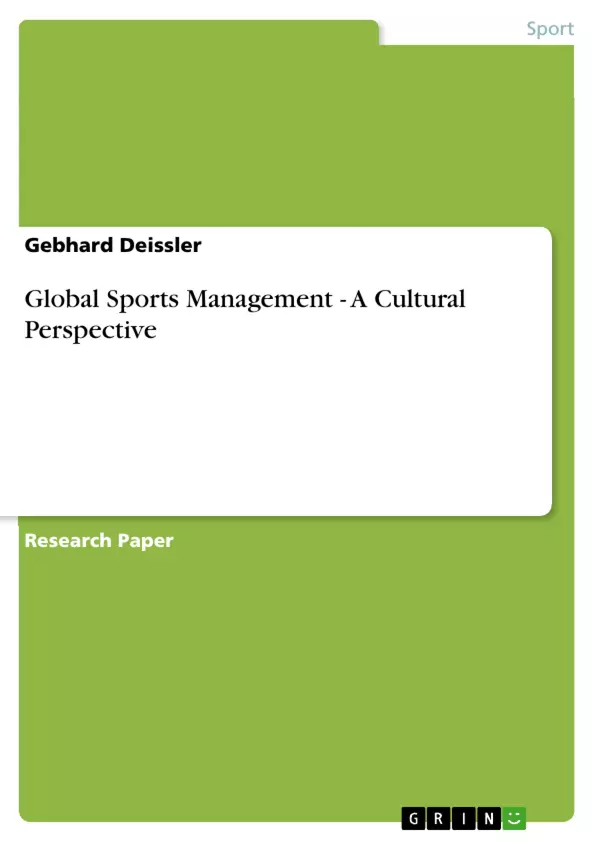The Ancient Roman adage “panem et circenses” (bread and games) still seems to set the rules of the global game in our days at a universal scale, while bread still seems to be at stake. While one part of the world is dying of hunger, in civil wars and other violence the other revels in global gaming. Nothing has changed fundamentally since Ancient Rome as far as basic human tendencies are concerned. And who does not play that game has been sidelined then as much as he is now. The arenas of the gladiators have become the arenas of global business, politics and sports. Neither the language nor the fundamental themes seem to have changed on the world’s stage, with its super predator global competitors, those who emulate them and the masses of the spectators. Global media allow the whole world to take part in the game, not just the few ones on site. Global competition for victory over a competitor and the global competition for the bread of survival and its enhancement, i. e. total
competition is the one theme that unites and divides all men, rich and poor, races, cultures, religions, ethnic groups, nations, organisations and sport organisations, federations, and clubs are simply another facet of the theme of competition, which necessarily entails losers, in sports, in politics, in business and above all with regard to bread, i.e. survival. Who refuses the game and proclaims deviating values from the mainstream ideology of panem et circenses will be prosecuted, as the Christians were prosecuted in Roman times as they are now in various places of the world. Diversity again emerges as a major issue at a global scale, internally and externally. In Roman days diversity could be controlled by Roman law and its military might across the Roman Empire that covered parts of three continents. The aspiration to global rule by major present day players is another parallel that transcends two millennia. Due to the emancipation of nations with their claim to sovereignty, however, it is has become difficult to enforce one global standard by global organisations and nations. Therefore the global diversity issue has arisen in our time, after the enforcement of global standards in the shape of various ideologies has also failed over the centuries.
Inhaltsverzeichnis (Table of Contents)
- Part 1
- Panem et Circenses: The Global Sports Business
- Intercultural Sports- and Soccer Management
- Five dimensions of global sports and soccer management
- The socio-historical aspect
- The Cultural Imperative of Global Sports
- Soccer from an economic/political standpoint
- Soccer from a sociopsychological perspective
- Cultural strategy, tactics and styles of soccer
- Part 2
- Culturally Integrative Global Sports Management
- Vishua Chaytana – Formulation of a Global Consciousness-Based Global Inter/Transcultural Management Science
- The completion of the intercultural edifice
- Design of a scientifically-based diversity-integrative transcultural profiler
- The state of the intercultural art and science: On human relativity in intercultural research
- Enhancing the intercultural art and science: Sources, models and the achievement of supreme cultural intelligence
- 36 Inter-/Transcultural Management Instruments
- Part 3
- Quantum Cultural Communication In The Planetary Third Millennium
- A Universal language for the universal era
- Part 4
- Transcultural Management Dictionar
Zielsetzung und Themenschwerpunkte (Objectives and Key Themes)
This work examines the complexities of global sports management through a cultural lens. It aims to bridge the gap between intercultural and transcultural management within the realm of international sports, particularly focusing on soccer. The text provides a comprehensive framework for understanding the diverse socio-historical, cultural, economic, and psychological dimensions of global sports.- The cultural imperative of global sports
- The role of culture in shaping sports strategies, tactics, and styles
- The development of a global consciousness-based approach to inter/transcultural management in sports
- The application of a scientific framework for understanding cultural diversity and integration
- The creation of a universal language for communication in the globalized sports environment
Zusammenfassung der Kapitel (Chapter Summaries)
Part 1, "Panem et Circenses: The Global Sports Business," sets the stage by exploring the historical and cultural context of global sports management, emphasizing the significance of soccer as a case study. It delves into the cultural imperative of global sports and its socio-historical evolution, analyzing the interplay of cultural factors, economic realities, political influences, and psychological perspectives. The chapter concludes by examining cultural strategies, tactics, and styles within the sport of soccer. Part 2, "Culturally Integrative Global Sports Management," focuses on establishing a theoretical framework for inter/transcultural management in global sports. It examines the challenges of cultural diversity and the need for a scientifically based, diversity-integrative transcultural profiler. This part explores existing intercultural research, proposing enhancements to the art and science of intercultural communication by identifying sources, models, and strategies for achieving cultural intelligence. Part 3, "Quantum Cultural Communication In The Planetary Third Millennium," delves into the concept of a universal language for the universal era, aiming to facilitate effective communication in a globalized sports environment. This chapter explores the potential for a language that transcends cultural boundaries and allows for seamless interaction among stakeholders from diverse backgrounds.Schlüsselwörter (Keywords)
The text explores the key themes of global sports management, intercultural and transcultural management, cultural intelligence, diversity-integrative approaches, cultural strategy, and communication in a globalized environment.- Quote paper
- D.E.A./UNIV. PARIS I Gebhard Deissler (Author), 2012, Global Sports Management - A Cultural Perspective, Munich, GRIN Verlag, https://www.grin.com/document/196784



